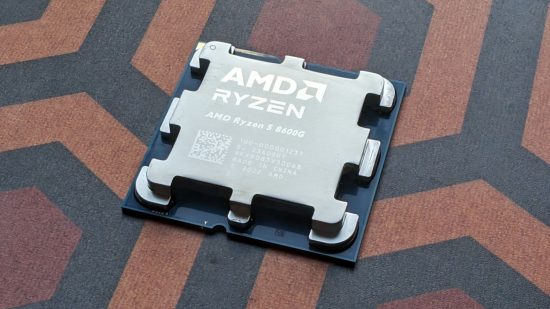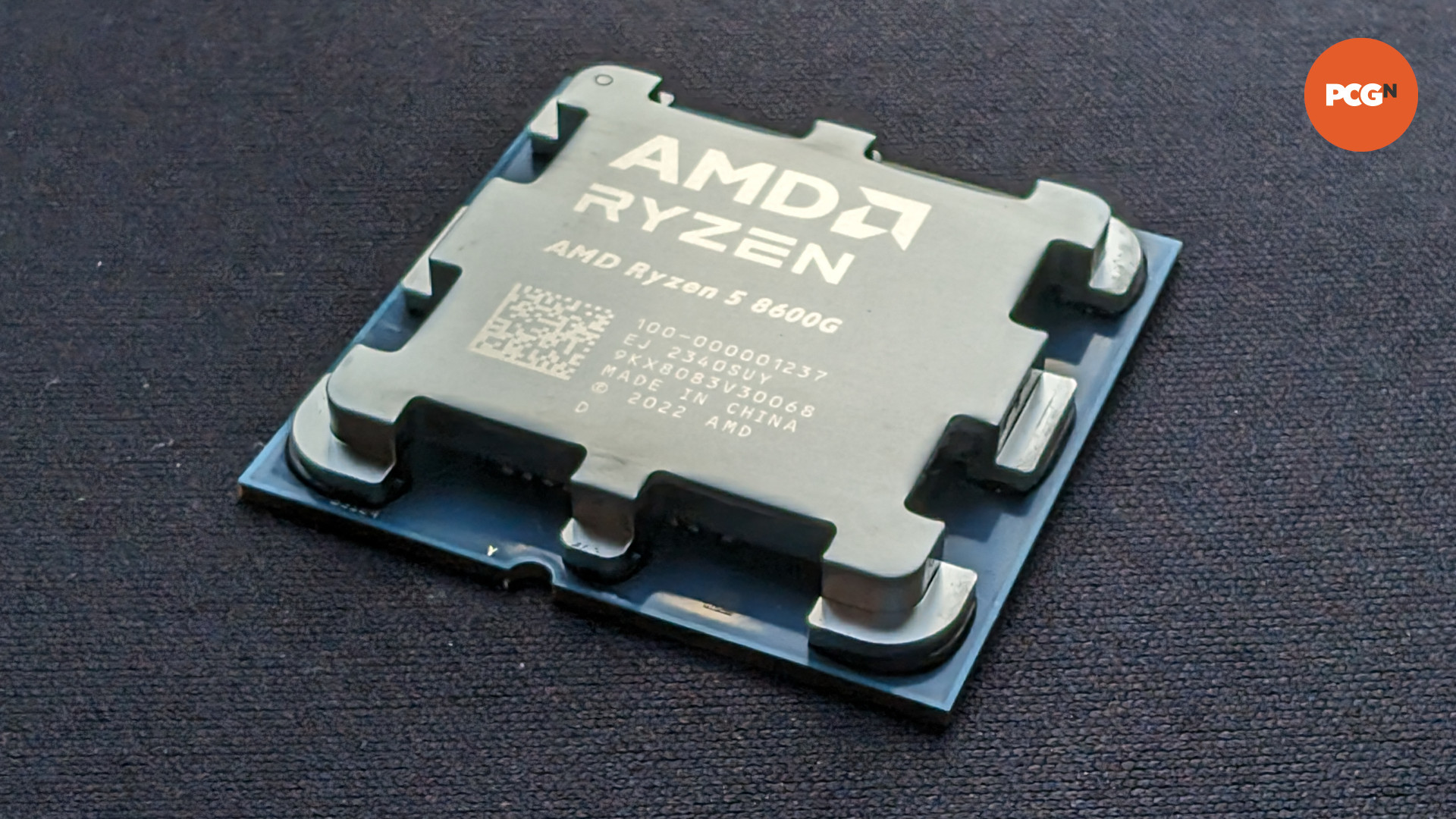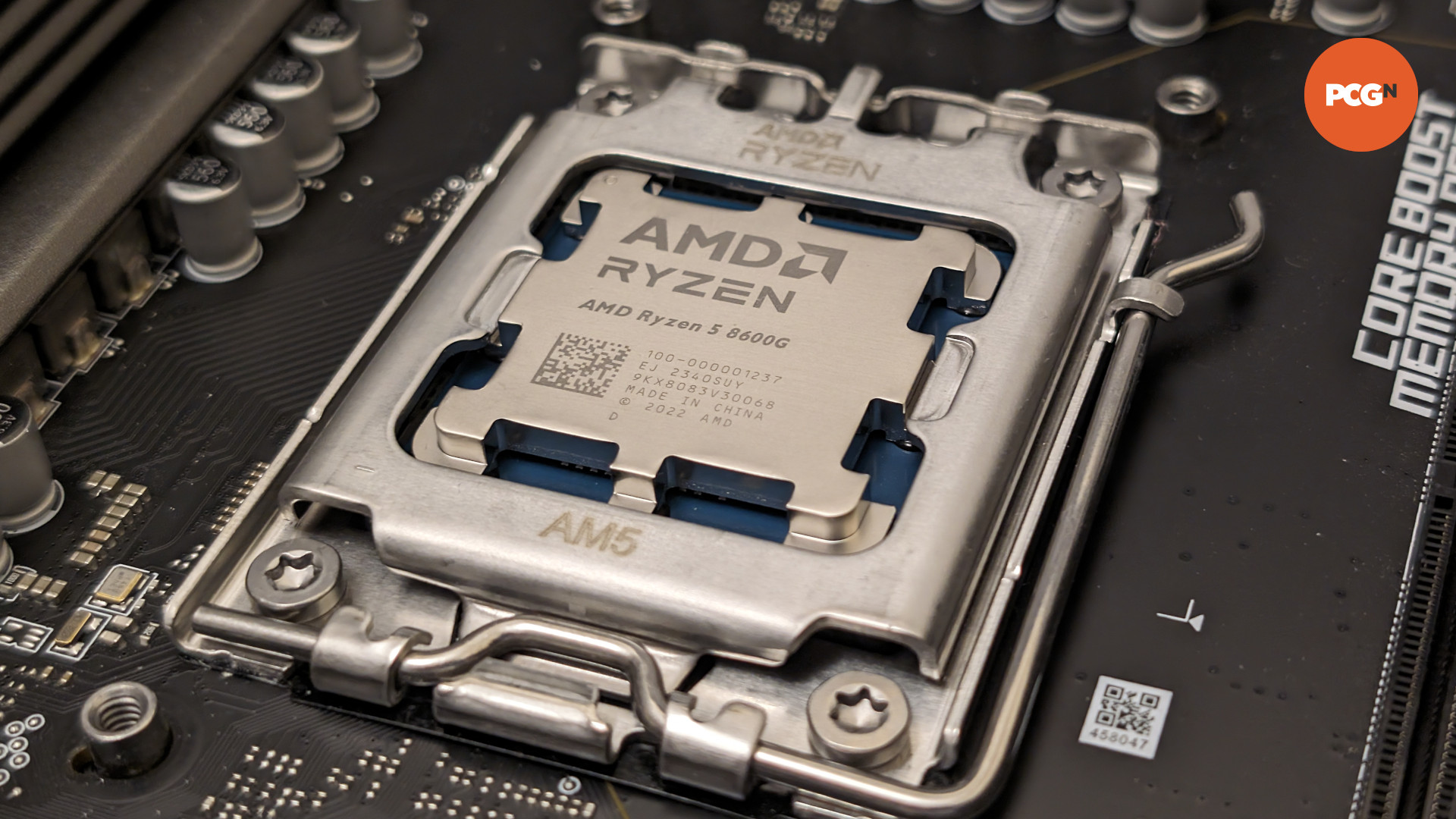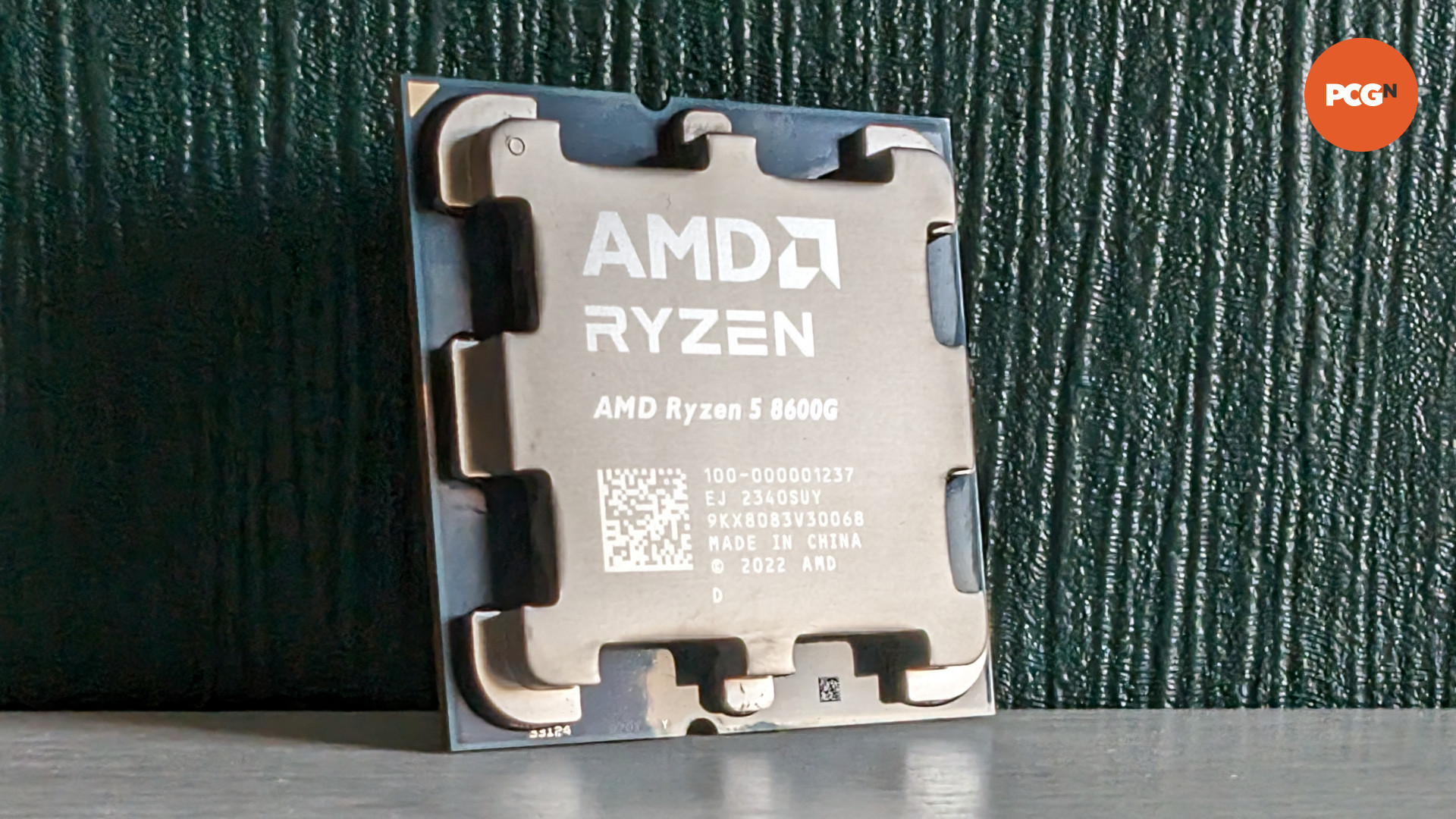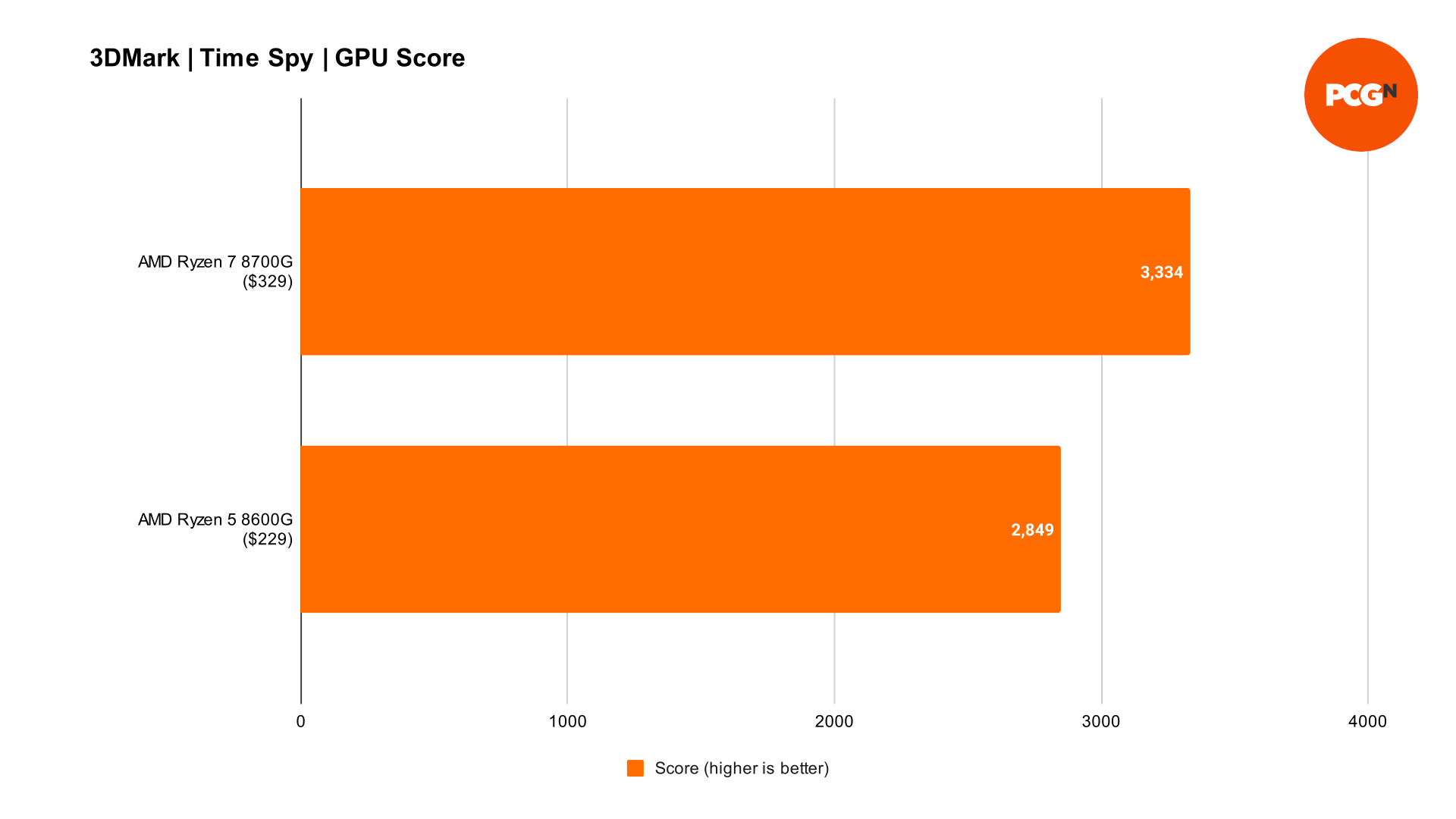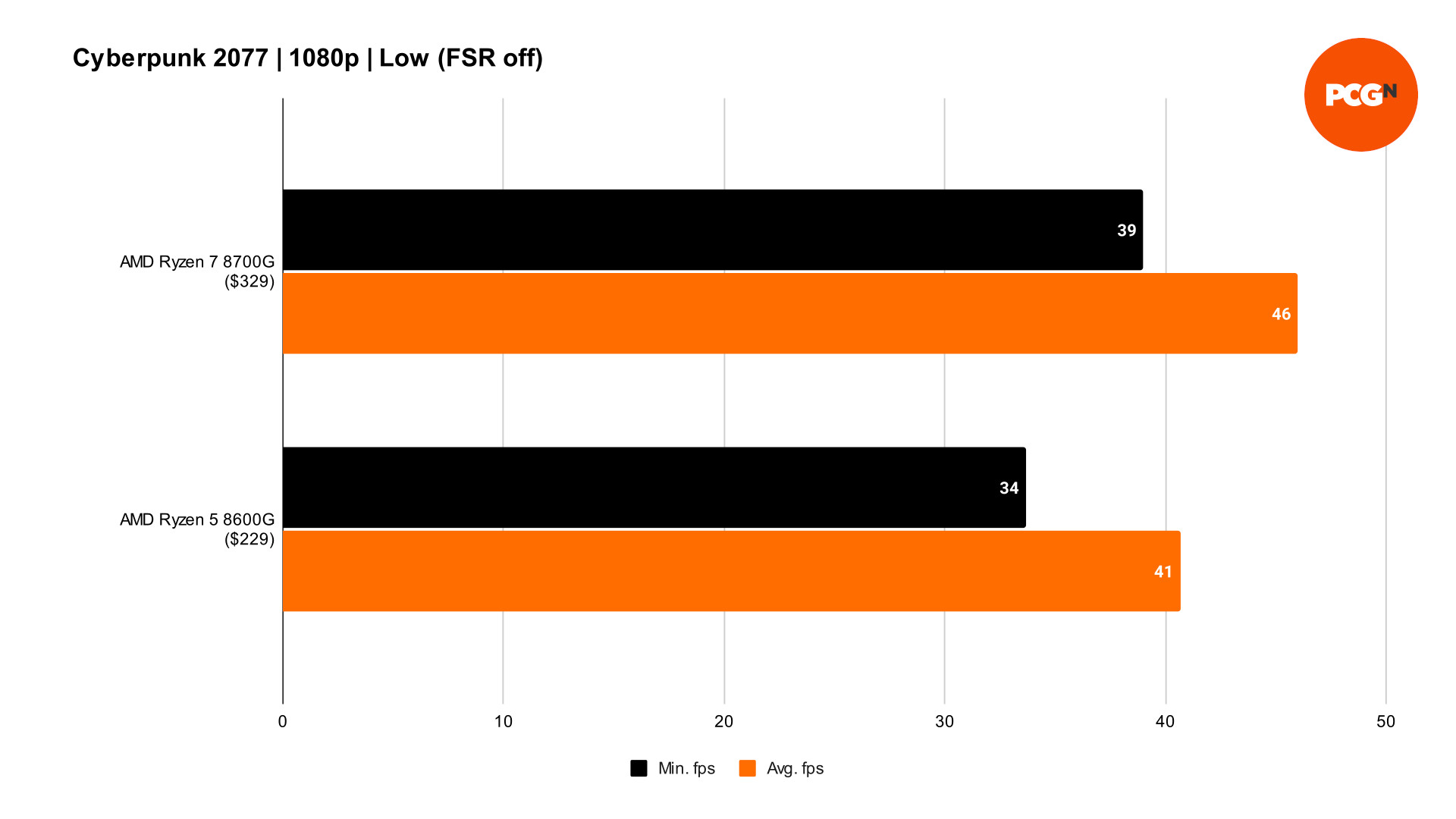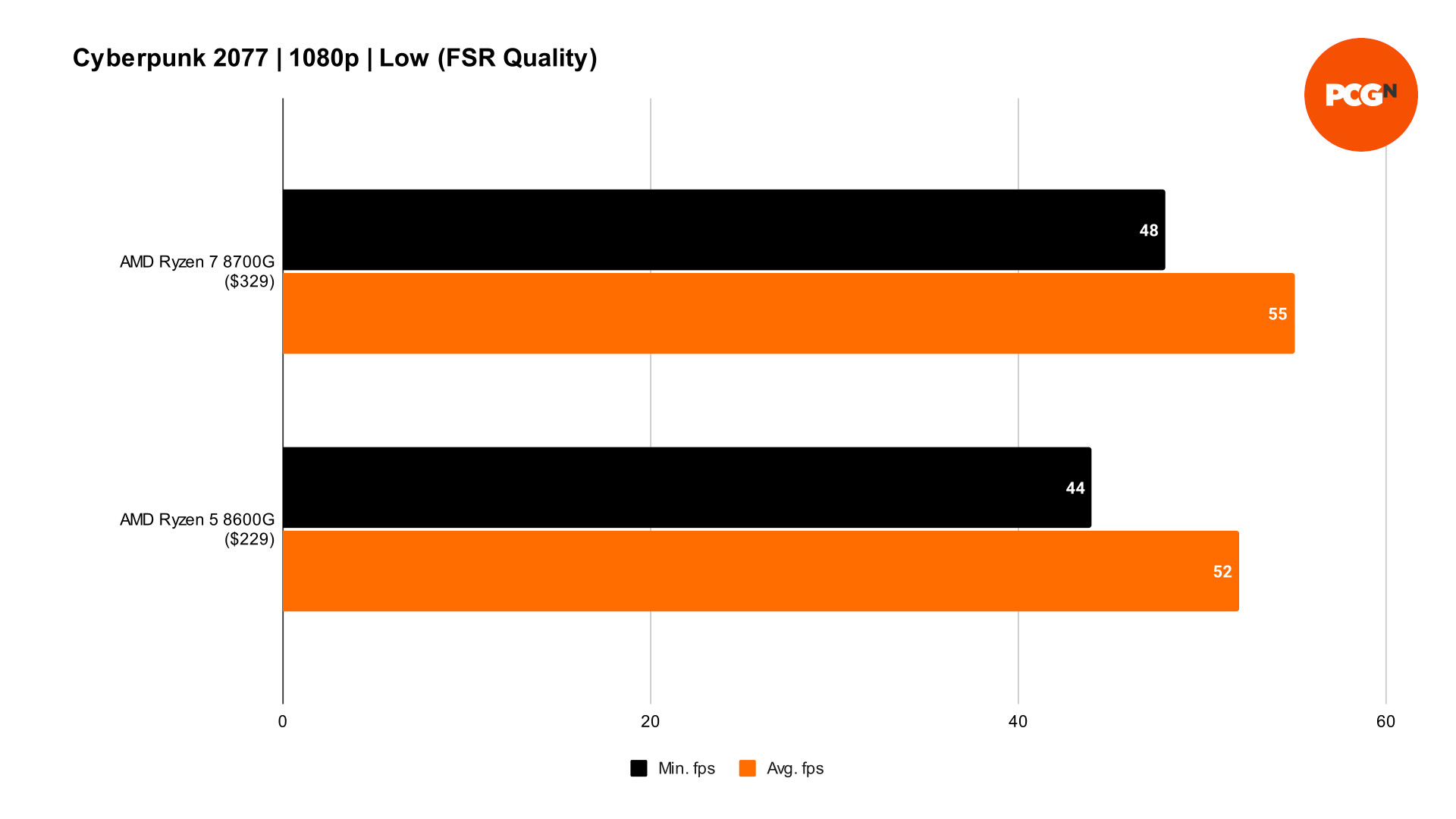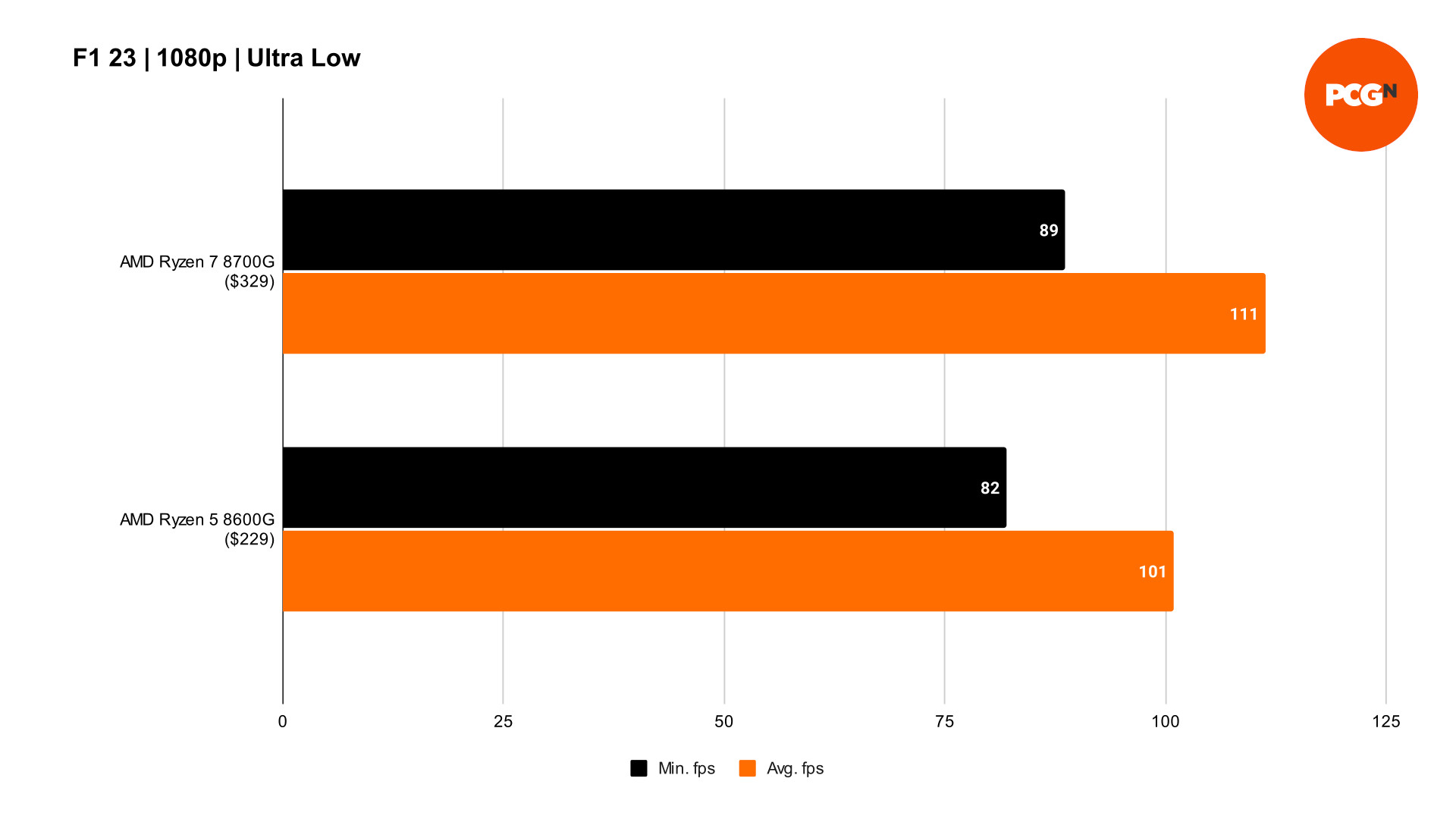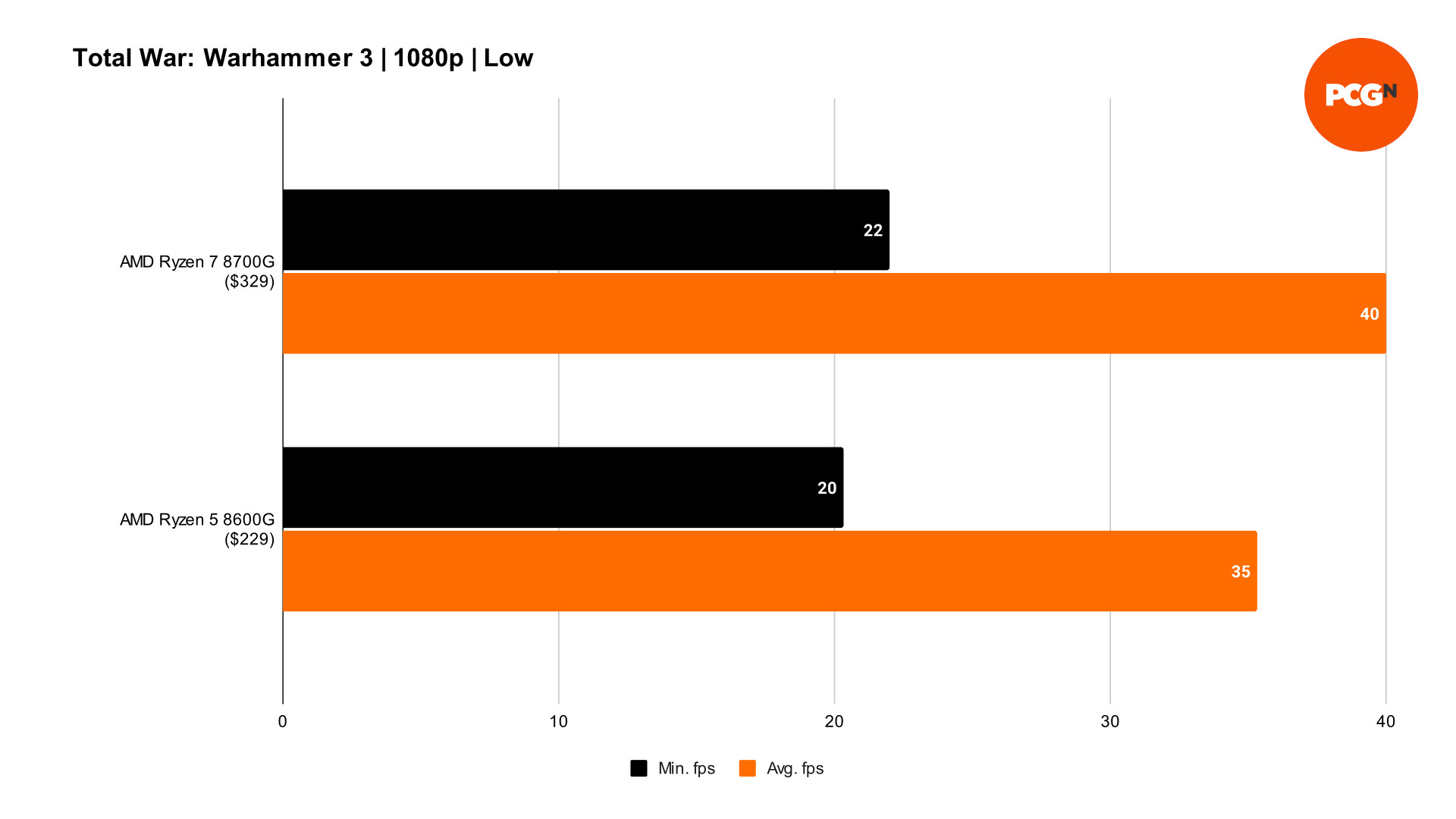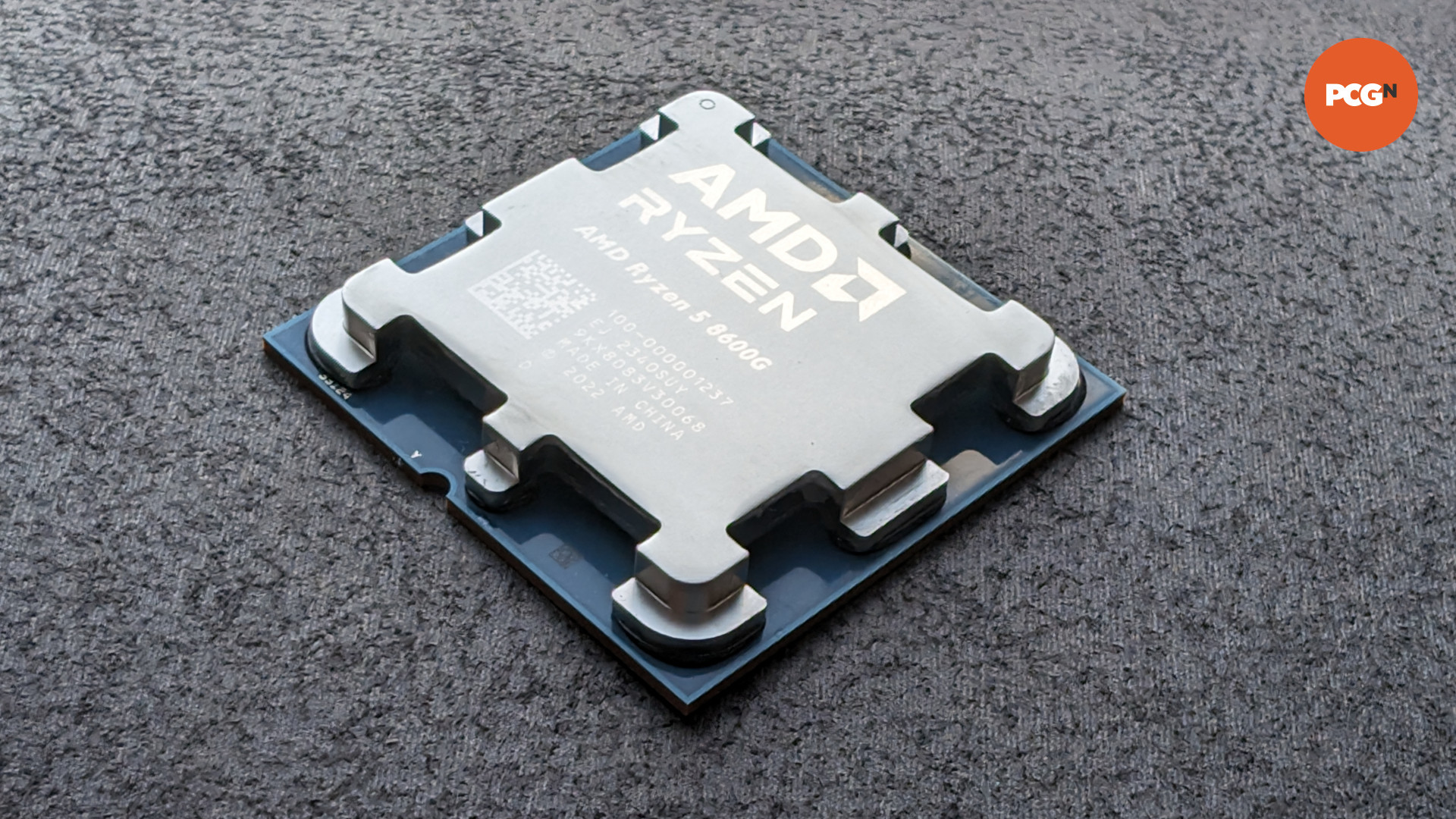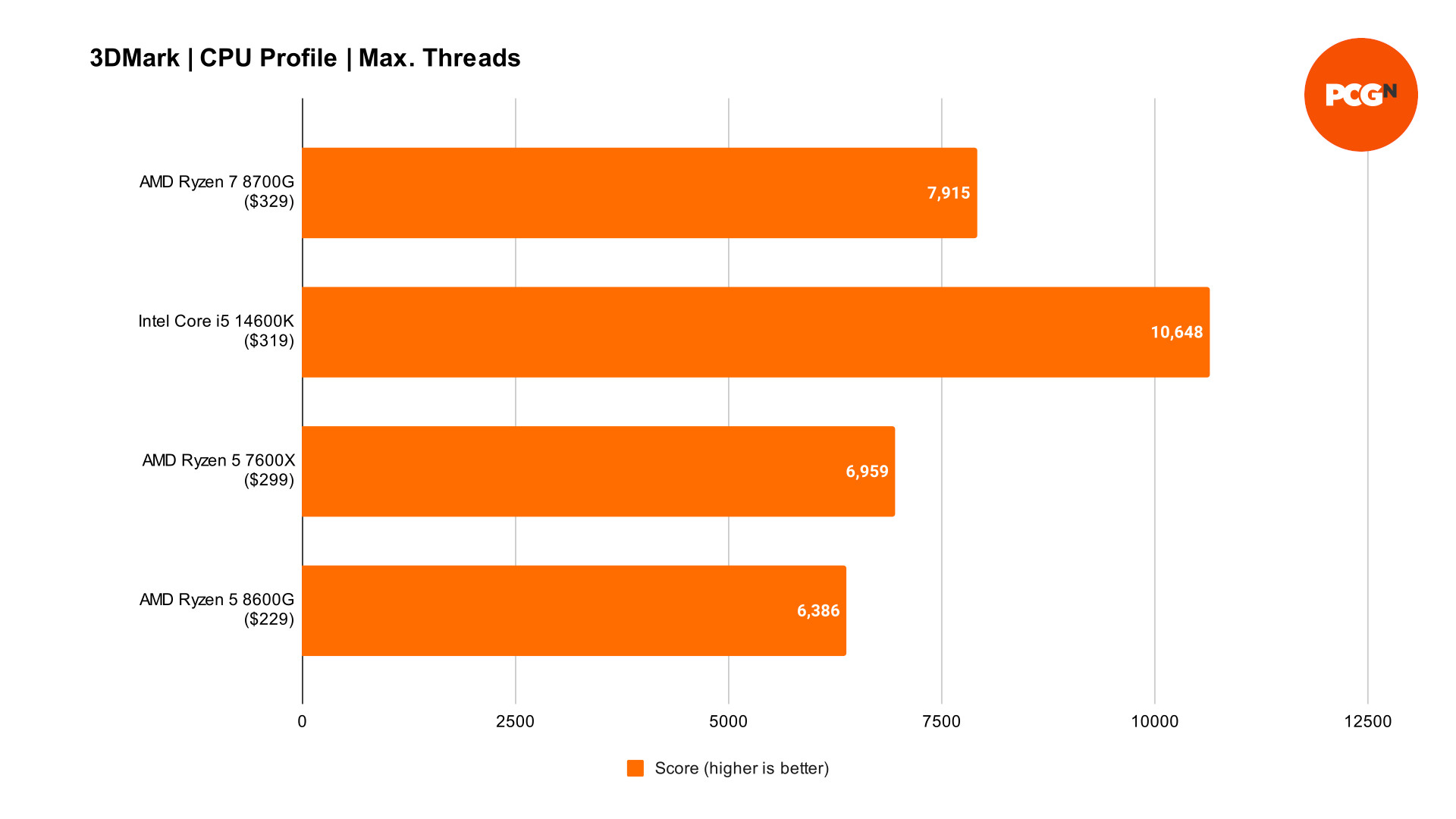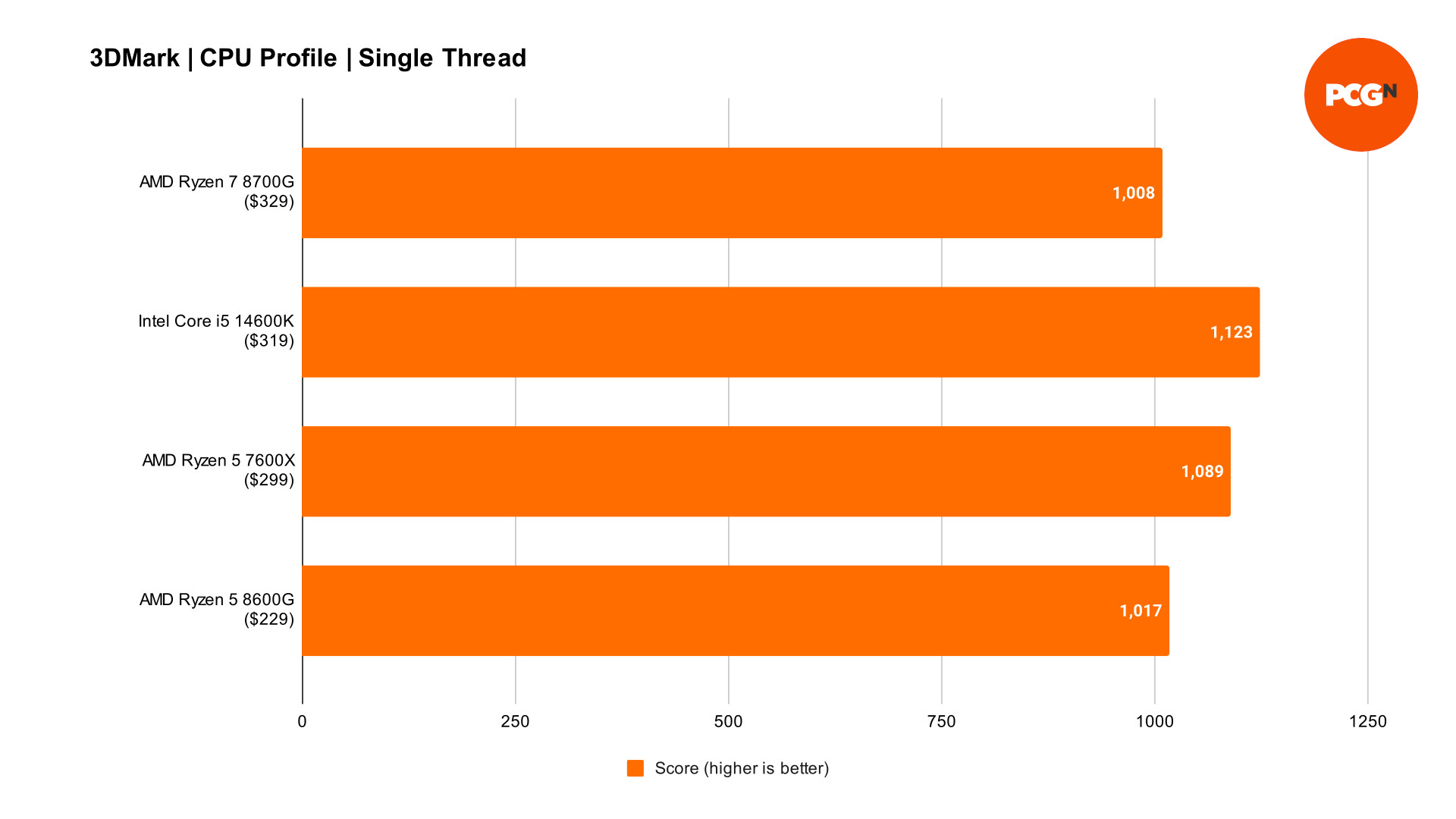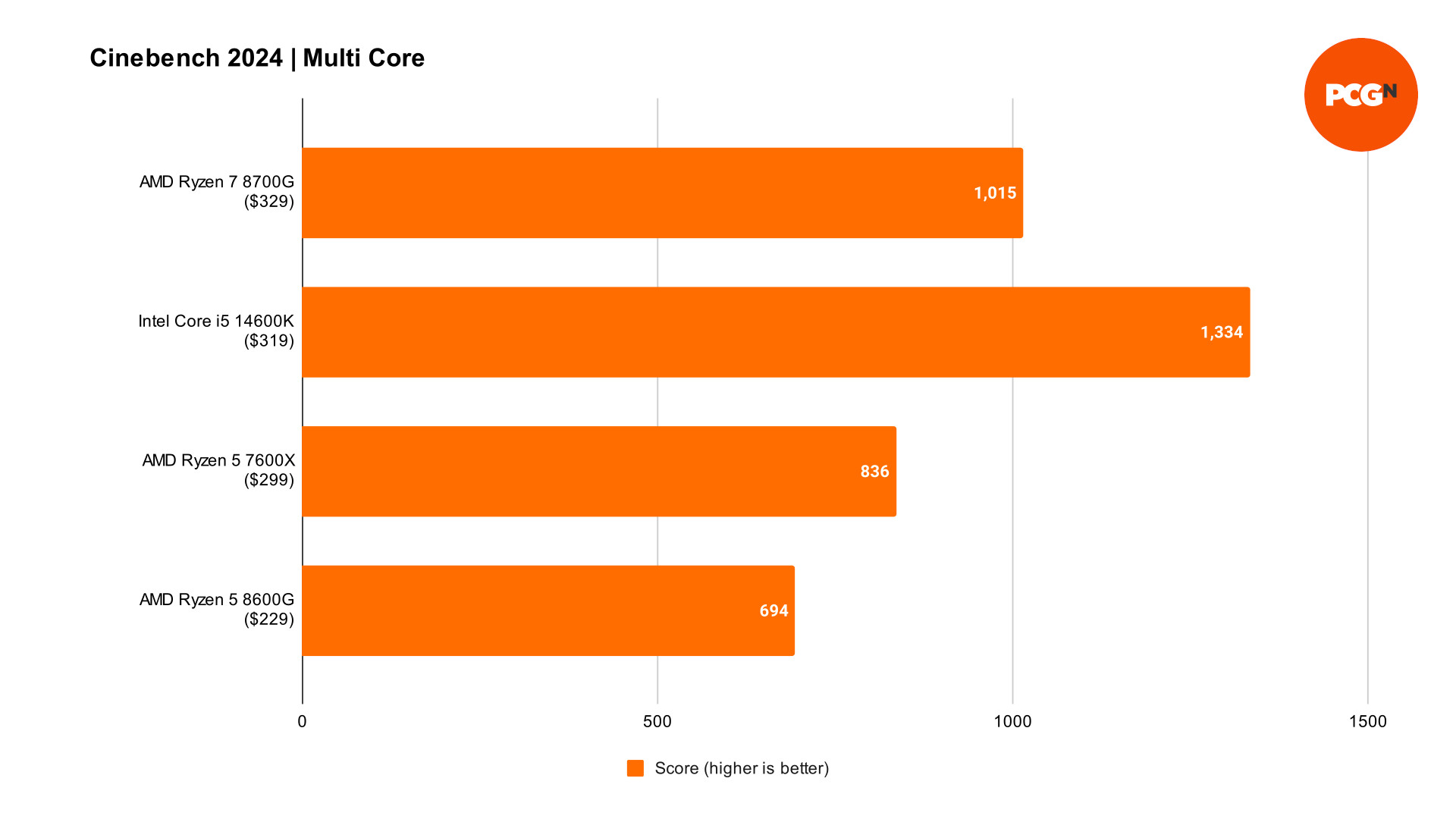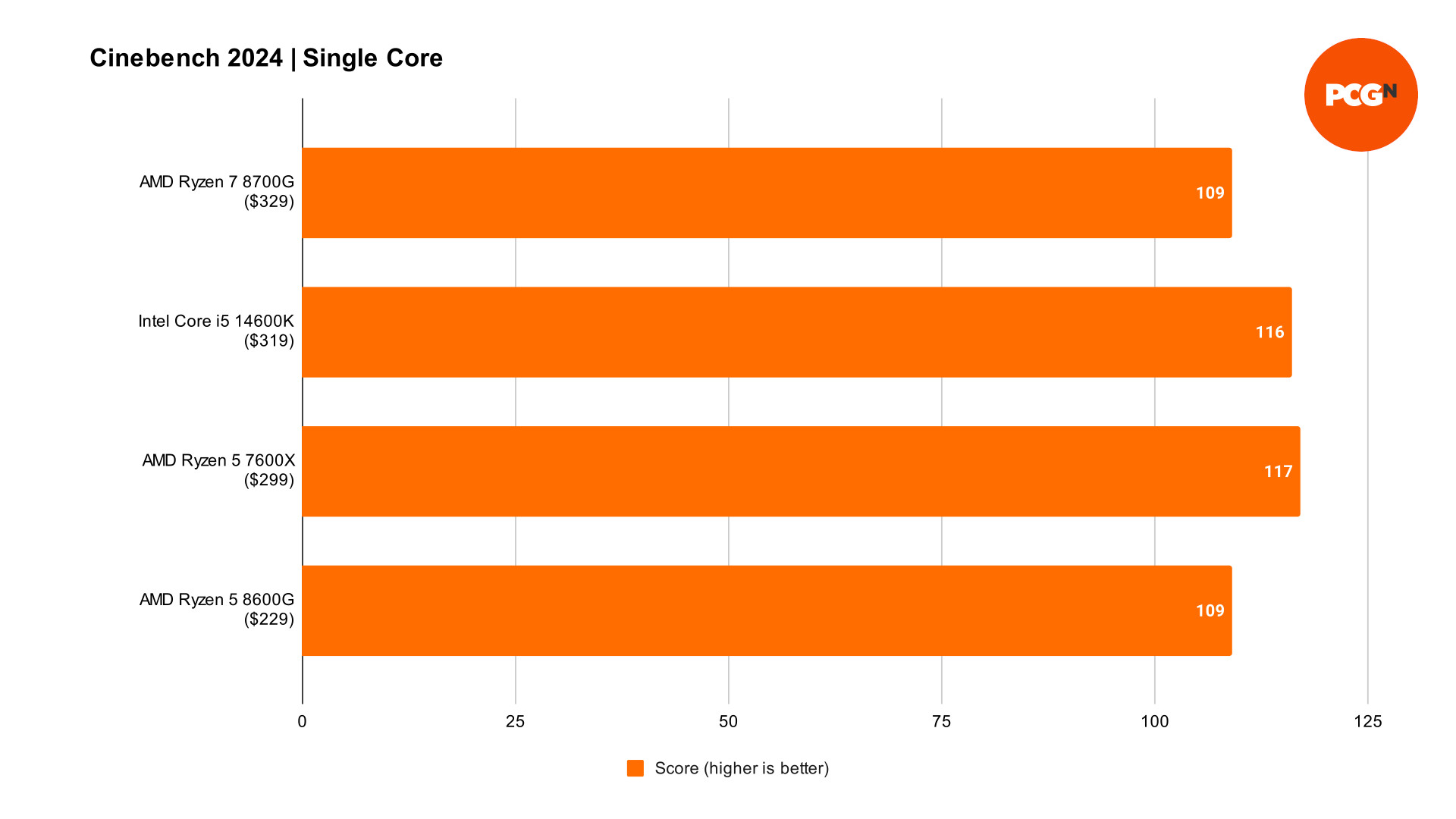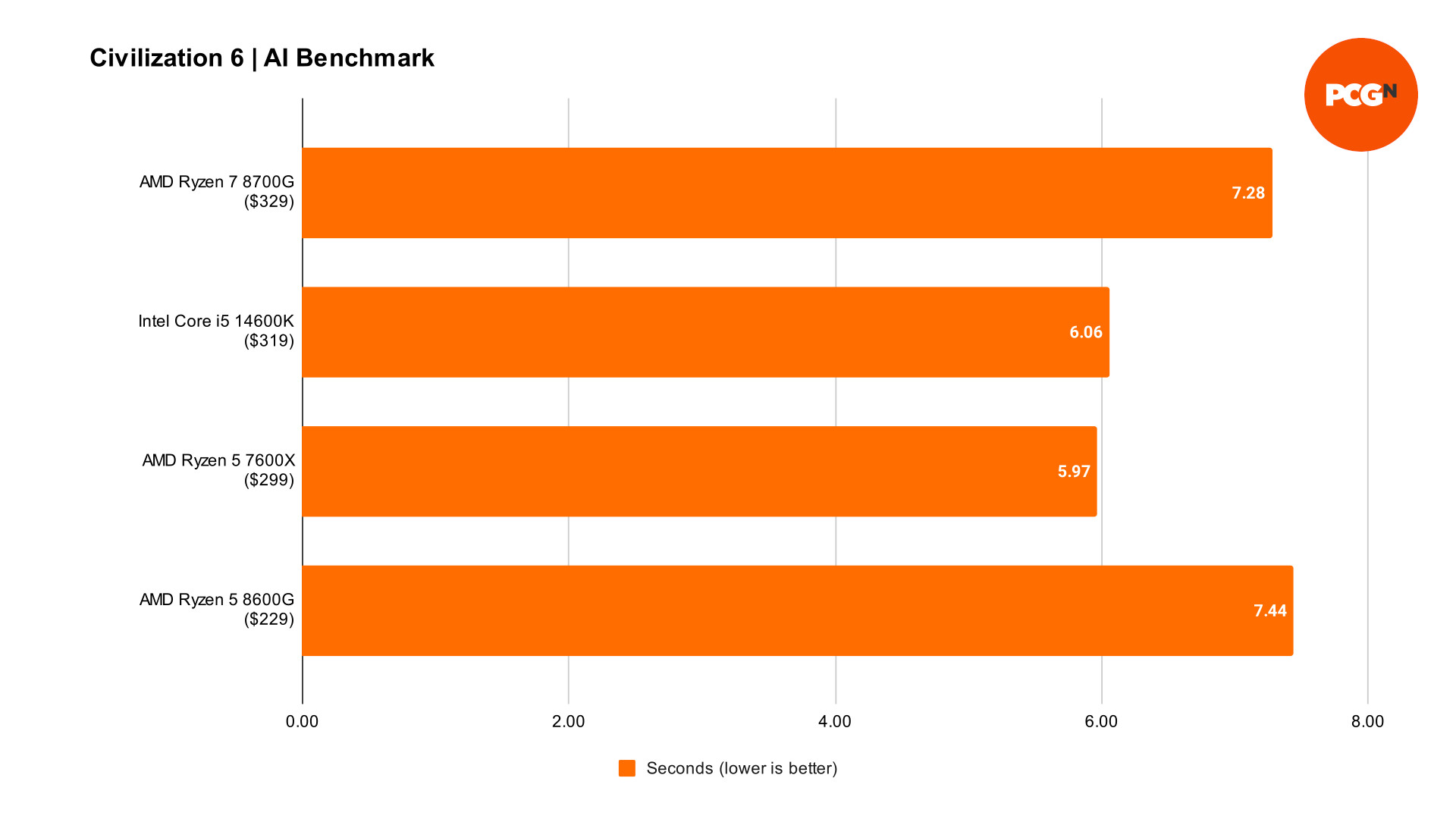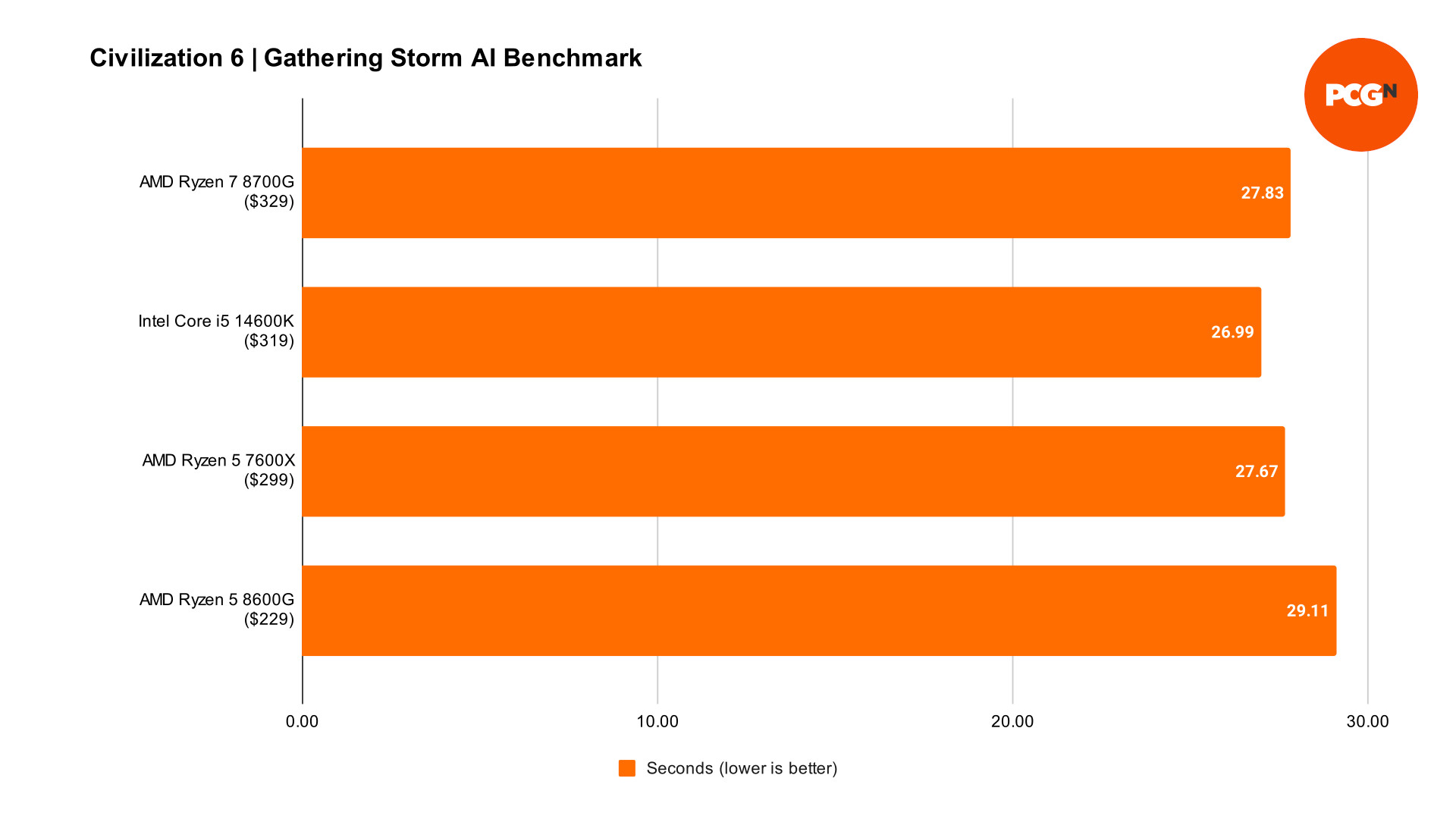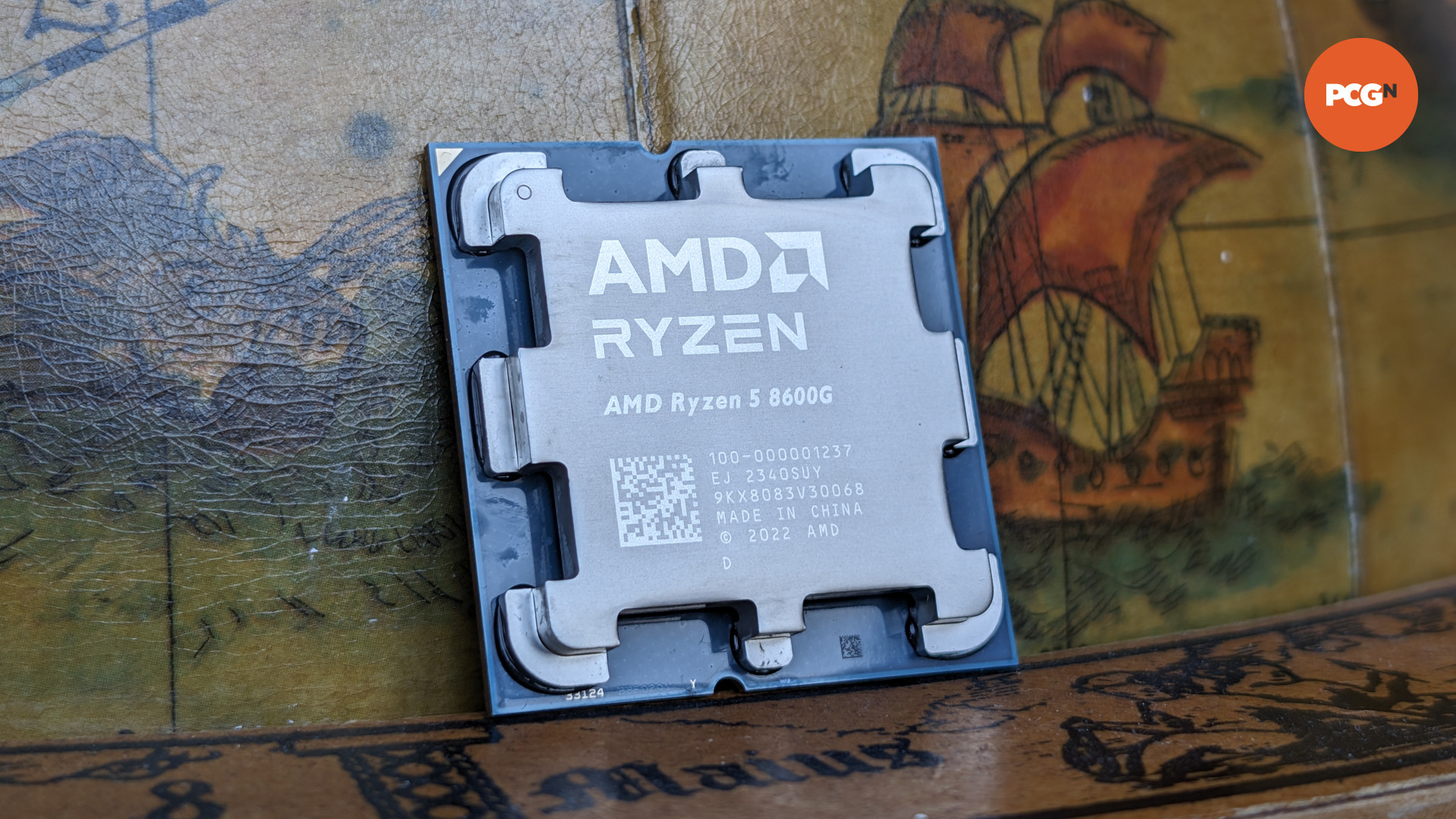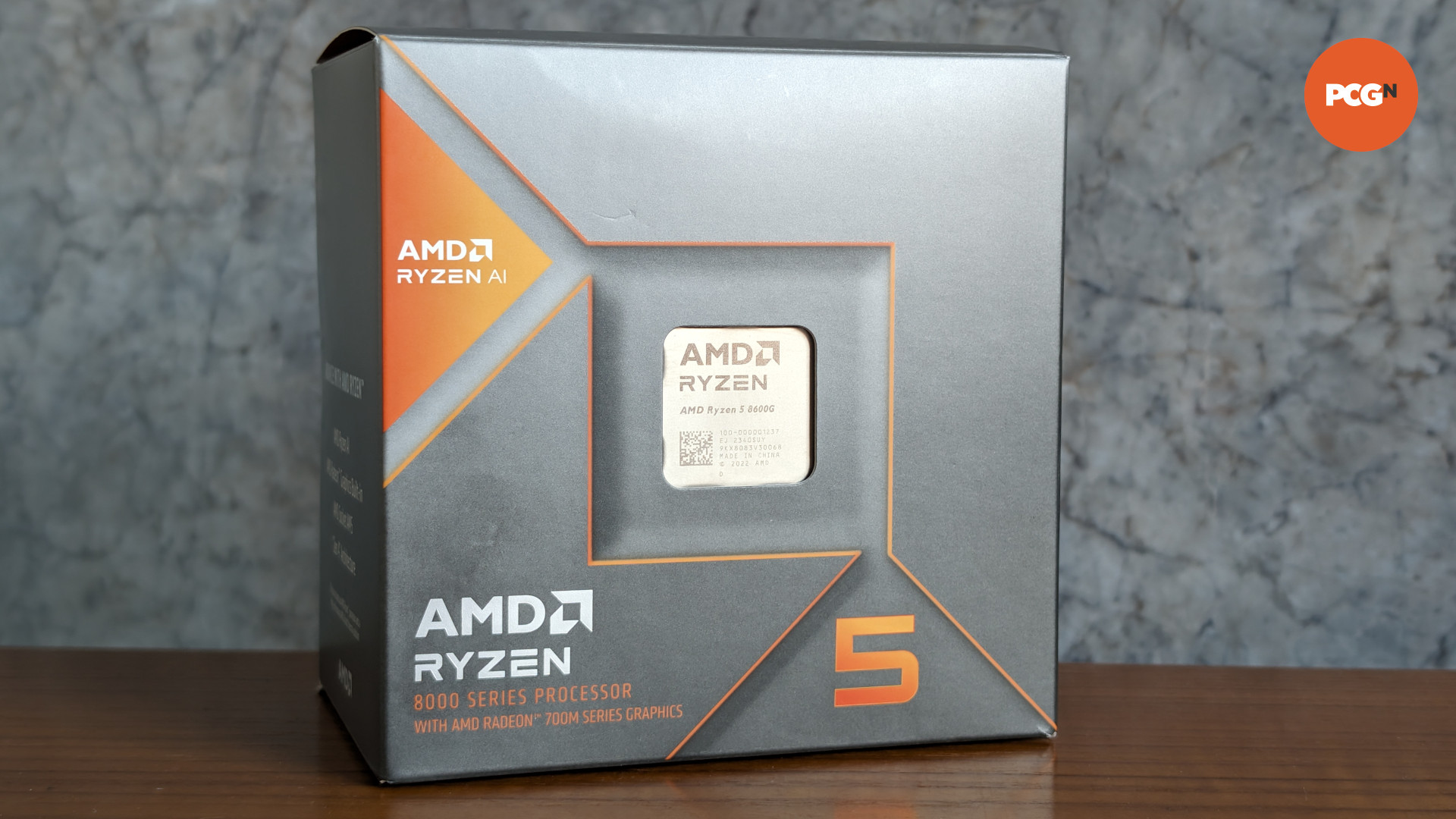Our Verdict
Impressive iGPU performance makes the Ryzen 5 8600G an appealing high-value choice as an APU, particularly compared to the more expensive Ryzen 5 8700G, providing it's paired with high-speed RAM. It's not shabby as a CPU either, but it pales to dedicated processors in terms of performance and PCIe lane support.
- Best value iGPU on the market
- Good CPU performance in games
- Included air cooler
- 6,000MHz+ RAM is a must for iGPU
- So-so value versus cheap graphics card
- Doesn't have 16x PCIe 4.0 lanes
AMD has finally crafted a new set of processors with relatively powerful integrated graphics using its latest CPU and GPU microarchitectures, Zen 3 and RDNA 3, giving rise to the Ryzen 5 8600G. It arrives on the scene devoid of competitors, save for its Ryzen 8000G series siblings and those from prior generations. In this limited area of competition, the 8600G comes out on top, but its value becomes questionable when it’s compared to dedicated processors and graphics cards
After testing the 8600G for the past few weeks, I can confidently describe it as the best gaming CPU with integrated graphics, otherwise known as an accelerated processing unit (APU), for most people. The more expensive Ryzen 7 8700G is reserved only for those that need more processor performance. AMD hasn’t earned this accolade without caveat, however, as this APU has some noticeable drawbacks.
Ryzen 5 8600G specs
The Ryzen 5 8600G CPU specs are closest to those of the Ryzen 5 7600, with both processors sporting six Zen 4 cores and 12 threads, with a TDP of 65W. However, the 8600G distinguishes itself slightly when it comes to frequencies, with a slightly lower maximum clock speed of 5GHz compared to 5.1GHz on the 7600, but a much higher base clock of 4.30GHz. It also only has 16MB of L3 cache, half that of the 7600.
| Ryzen 5 8600G | Ryzen 7 8700G | |
| Socket | AM5 | AM5 |
| Cores | 6 (Zen 4) | 8 (Zen 4) |
| Threads | 12 | 16 |
| Base clock | 4.3GHz (4,300MHz) | 4.2GHz (4,200MHz) |
| Max. boost clock | 5GHz (5,000MHz) | 5.1GHz (5,100MHz) |
| L2 cache | 6MB | 8MB |
| L3 cache | 16MB | 16MB |
| PCI Express version | PCIe 4.0 | PCIe 4.0 |
| PCI Express lanes (total / usable) | 14 /10 | 14 / 10 |
| iGPU model | Radeon 760M | Radeon 780M |
| iGPU compute units | 8 (RDNA 3) | 12 (RDNA 3) |
| iGPU frequency | 2.8GHz (2,800MHz) | 2.9GHz (2,900MHz) |
| TDP | 65W | 65W |
For all these similarities, though, the 8600G’s integrated graphics are much more capable. Not only does it pack more compute units (CUs) than any Ryzen 7000 series processor, eight in total, but each CU is also based on the latest RDNA 3 GPU architecture. Naturally, this is primarily what gives the 8600G greater levels of integrated GPU (iGPU) performance versus the aging, Vega-based Ryzen 5 5600G that it effectively succeeds, in addition to a much higher iGPU frequency of 2.80GHz.
Unlike its 5000 series predecessor, however, the 8600G fits into the AM5 socket and needs to be paired with DDR5 RAM. While these two specifications make building a PC with this APU more expensive compared to an AM4 system, the difference in performance and potential upgrade paths make its higher cost worthwhile.
That said, the 8600G and its siblings support fewer PCIe lanes than their 7000 series counterparts, and they don’t support PCIe 5.0 either, topping out at PCIe 4.0 instead. This makes them incapable of properly supporting PCIe 5.0 NVMe SSDs, but they’ll still be able to run at 4x PCIe 4.0 speeds. More importantly, though, any dedicated graphics card will be limited to 8x PCIe 4.0. This doesn’t affect today’s pixel pushers too much, but future GPUs using a 16x PCIe 5.0 interface may prove a problematic pairing for the 8600G, as they will only get eight lanes of PCIe 4.0 bandwidth.
The 8600G is also one of the first desktop processors to feature a neural processing unit (NPU) to boost performance in local AI workloads. As this has no bearing on gaming performance at this point in time, we won’t be exploring its capabilities, but this may change should Zen 5 CPUs, which are expected to launch later this year, introduce image or performance enhancing features using an NPU.
Summarily, the 8600G’s specs would be a no-brainer versus similarly specced 7000 series processors were it not for the markedly reduced number of PCIe lanes. This, of course, is speaking from the perspective of someone looking to eventually pair the APU with a dedicated graphics card. If you have no intention of doing so, or don’t mind sacrificing some performance on a PCIe 4.0 card, it becomes much easier to live with this drawback.
Ryzen 5 8600G performance
To measure the CPU and GPU performance of the Ryzen 5 8600G, we’ve run the APU through our usual assortment of processor benchmarks, and we’ve also put the iGPU through an amended version of our graphics card test suite. These changes are detailed in the GPU benchmarks section of this review, and are designed to present a more realistic use case of the 8600G.
| Test PC specs | |
| CPU | AMD Ryzen 5 8600G |
| CPU cooler | AMD Wraith Stealth |
| GPU | Radeon 760M |
| GPU driver | AMD Software: Adrenalin Edition 24.2.1 |
| RAM | G.Skill Trident Z5 Neo RGB 32GB (2 x 16GB) DDR5 6,400MHz |
| Motherboard | MSI B650 Gaming Plus WiFi |
| SSD | WD Black SN850X 2TB |
| OS | Windows 11 Pro 23H2 (22631.3155) |
| PSU | be quiet! Straight Power 12 1,000W |
| Case | be quiet! Shadow Base 800 FX |
Our test PC for the 8600G differs from our other CPU reviews, with AMD providing a B650 motherboard and 6,400MHz RAM kit for our testing in addition to the processor sample itself. This setup is much more representative of a setup befitting the 8600G, and also highlights some iGPU performance insight that would not have otherwise been possible using our usual memory configuration.
Ryzen 5 8600G GPU benchmarks
The majority of the Ryzen 5 8600G’s appeal lies in its iGPU, as the Radeon 760M included here makes the 8600G an all-in-one chip for those unable or unwilling to include a dedicated graphics card in their PC. While it’s not the most powerful option on the market, with the Radeon 780M in the Ryzen 7 8700G serving as the new champion, it’s close enough to the point where the 8600G comes away as the better value option.
While this iGPU is powerful in relation to the rest of the market, it’s still very limited compared to a dedicated graphics card, even going as far back as relatively old entry-level models, such as the Nvidia GeForce RTX 2060 or AMD Radeon RX 5600 XT. You’re essentially locked into gaming at 1080p with low graphics presets while playing modern games on the 8600G, often with frame rates just north of 30fps. Features like FidelityFX Super Resolution (FSR) upscaling can help boost performance, but the baseline from which it has to work is inescapably low.
The fact remains, though, that there is no other CPU with integrated graphics that performs like the 8600G at this price. Its iGPU performance is a massive step above everything found in the Ryzen 5000G series, transforming previously choppy games into playable experiences. While it has niche appeal, seeing its capabilities in action makes it hard not to admire this chip.
Ryzen 5 8600G 3DMark Time Spy
3DMark Time Spy is a synthetic benchmark that provides us with a general impression of a GPU’s capabilities, running at 1440p with no ray tracing effects enabled.
Lacking scores for the Ryzen 5000G series, our only points of comparison are with budget graphics cards and CPUs with iGPUs not suitable for gaming. This is admittedly unfair, but it nonetheless reveals the gargantuan GPU gap between the Ryzen 5 8600G and current-generation graphics cards.
Scoring 2,849, the 8600G is only just under 500 points behind the Ryzen 7 8700G, a strong result given their $100 price difference. However, bringing the Radeon RX 7600 into the mix sees the graphics card’s performance dwarf that of the 8600G by 393% with its score of 11,199. To the 8600G’s credit though, it similarly leaves the mighty Ryzen 7 7800X3D feeling similarly small, beating its score of 704 to the tune of 404%.
These results, and those in the rest of this review, were achieved using the RAM’s EXPO profile, boosting its speed to 6,400MHz from its stock speed of 4,800MHz. Running the dual-channel 32GB kit at 4,800MHz resulted in noticeably worse performance from the iGPU, so if you’re hoping to get the most out of the 8600G, aim for the 6,000MHz sweet spot when it comes to memory frequency.
Ryzen 5 8600G Cyberpunk 2077
Cyberpunk 2077 is now officially playable in the full sense of the word on a desktop processor, as the Ryzen 5 8600G musters an average frame rate of 41fps. Just as importantly, and impressively, the 8600G also surpasses the 30fps minimum frame rate floor necessary to keep the experience from turning into a slideshow.
The Ryzen 7 8700G is just 5fps ahead of the 8600G, in both minimum and average frame rates, succinctly highlighting the difference in value between these APUs when it comes to iGPU performance. Yes, the 8700G is more powerful, but the majority of its value lies in CPU performance, as we’ll explore in more detail in later benchmarks.
This is, of course, using the game’s ‘Low’ graphics preset at 1080p, so while Cyberpunk 2077 is playable you won’t be looking at Night City in its best (neon) light. We can afford ourselves more headroom, however, through the use of AMD FSR 2.1 upscaling.
As we’re playing Cyberpunk 2077 at 1080p, I’ve opted to use the ‘Quality’ preset to minimize any loss to image fidelity while also netting a welcome performance boost. Doing so sees a 9fps jump in average frame rate and a 10fps boost to the minimum frame rate, which naturally makes for a smoother experience but also gives you headroom to turn up the graphics presets.
The 8600G does support FSR 3 frame generation, but Cyberpunk 2077 is yet to add the feature, and enabling it wouldn’t be recommended with these frame rates anyway (with the company setting the recommended floor at ~60fps). Still, it’s worth remembering that this tool is available should you have it available in less demanding games.
Meanwhile, the included Wraith Stealth Cooler does a good job of keeping the temperatures of the 8600G in check, with the CPU topping out at 77.3°C and the maximum GPU temperature clocking in at 65.5°C. As with other non-X Ryzen 7000 series processors, there really is no need to swap it out for a more powerful cooling system.
Ryzen 5 8600G F1 23
F1 23 highlights the surprising capabilities of the Ryzen 5 8600G in less demanding games, achieving triple-digit frame rates. Using the game’s ‘Ultra Low’ graphics preset, we achieve an 82fps minimum frame rate and 101fps average frame rate, both well in excess of the 60fps floor you’d want for a racing game.
These kinds of results give us the room to push performance further with FSR upscaling, or claw back some image fidelity by upping our graphics settings. I do wish that F1 23 supported FSR frame generation, though, as I’m curious to see how much further the feature could help push the 8600G’s performance.
As with Cyberpunk 2077, the superior iGPU in the Ryzen 7 8700G doesn’t pull all that much further ahead of the 8600G. At worst, there is a mere 10fps separating the two APUs, which doesn’t matter very much at all in this scenario, as each chip is already pushing over 100fps.
Ryzen 5 8600G Total War: Warhammer 3
When we turn to Total War: Warhammer 3, the limitations of the Ryzen 5 8600G rear their head, as the game stretches both the CPU and GPU in its Mirrors of Madness benchmark. A respectable average frame rate of 35fps is unfortunately undermined by a minimum frame rate of 20fps, with the most intense scenes of battle proving too much for the iGPU to maintain a consistent frame rate.
The Ryzen 7 8700G similarly suffers, continuing to offer meager gains against the 8600G. Sadly, there’s little we can do to alleviate the pressure here, as Total War: Warhammer 3 doesn’t support FSR upscaling. We could use Radeon Super Resolution (RSR) to provide some breathing room, but the quality of its upscaling compared to a native FSR implementation is worse to the point that I don’t recommend using it, particularly at 1080p when the tech has so few pixels with which to work.
Total War: Warhammer 3, then, serves as a reminder then that not all games will be playable on these APUs, unless you’re comfortable with turning down the graphical dial in the purest pursuit of performance, image quality be damned.
Ryzen 5 8600G CPU benchmarks
As a CPU, the Ryzen 5 8600G is capable but much less remarkable compared to its ability to serve as a graphics card stand-in. As we highlighted earlier, it has a similar specification to the Ryzen 5 7600 save for differences in clock speed and L3 cache. That’s not forgetting the reduction in supported PCIe lanes, as well as its lack of PCIe 5.0 support.
This isn’t to entirely dismiss the 8600G as a CPU, as it still has plenty of performance to offer in games and does decently in more production-oriented workloads. It’s just that opting for any 8000G series chip, purely as a processor, over a similarly-specced or priced Ryzen 7000 series chip only makes sense if you need an iGPU for more than a display output.
Ryzen 5 8600G 3DMark CPU Profile
Unsurprisingly, the Ryzen 5 8600G finds itself at the bottom of our chart as it’s the least capable CPU among our points of comparison. Using all 12 of its threads, the 8600G scores 6,386, falling 573 points behind the Ryzen 5 7600X, which sports the same thread count. The difference here comes down to clock speeds, cache, and TDP, with the 7600X sporting higher values in all three categories, and we’d expect to see the Ryzen 5 7600 sit between the two processors.
Naturally, the Ryzen 7 8700G and Core i5 14600K pull much further ahead with a larger amount of threads at their disposal, 16 and 20 respectively. The 14600K has the highest TDP (125W) of all the CPUs listed here and, like the Ryzen 5 7600X, incurs the additional cost of a separate CPU cooler purchase. A more apt point of comparison would be the Core i5 14400, which sports a 65W TDP, includes a cooler, and is priced similarly to the 8600G. Even so, its integrated graphics would pale in comparison to any 8000G series chip.
Despite sporting a lower boost clock, the 8600G somehow manages to pull ahead of the 8700G in the 3DMark single threaded benchmark, albeit only slightly. Still, each 8000G processor finds itself falling behind the 7600X and 14600K, which each boast higher clocks and more power at their disposal.
Ryzen 5 8600G Cinebench 2024
Cinebench 2024 proves to be an unkind benchmark for the Ryzen 5 8600G, as its relative specification shortcomings once again leave it decidedly behind the Ryzen 5 7600X. This isn’t surprising and once again highlights that while the 8600G is a compelling APU, its processing power should not be the primary reason to reach for it in favor of a more traditional CPU.
The differences are less stark in Cinebench 2024 once we swap from multi core to single core rendering, but once again both the Ryzen 7 8700G and 8600G find themselves at the back of the pack. Despite there only being 8 points between them and the frontrunner, the Ryzen 5 7600X, every point matters all the more here, shaving minutes off of a total render time.
Ryzen 5 8600G Civilization 6
Turning away from synthetic benchmarks, Civilization 6 provides fertile ground to test the CPU chops of the Ryzen 5 8600G and its competitors in a real-world gaming scenario. Starting with the game’s vanilla ‘AI’ benchmark which features a small amount of computational tasks to complete, the APU is slower than both the Ryzen 5 7600X and Core i5 14600K.
The average turn for each faction is completed in 7.44 seconds by the 8600G, 1.47 seconds behind the 7600X. While that’s not a massive difference on paper, that extra time spent waiting before you can make your next move is more noticeable in practice. Still, much as it’s the worst result here, it’s by no means awful and remains impressive once you consider the APU is also rendering the game’s graphics simultaneously.
Naturally, as the complexity of each turn grows in the Gathering Storm AI Benchmark, the gap between the 8600G and the frontrunner, now the Core i5 14600K, widens. Now, the difference in the average turn time between the APU and the fastest CPU has grown to 2.12 seconds. Speaking from experience, late-stage Civilization 6 games against AI require so much baseline patience that the extra waiting time isn’t as noticeable as it is earlier on.
Ryzen 5 8600G price
At $229, the Ryzen 5 8600G is one of the cheapest Zen 4 processors ever, matching the MSRP of the Ryzen 5 7600 and putting it in competition with the likes of the Core i5 14400. However, the Ryzen 5 7600X can now be regularly found well below its $299 MSRP, making it a better-value buy if you can afford to spend some extra bucks on a decent cooler.
Comparisons to similarly priced CPUs only matter, however, if you’re planning to pair the 8600G with a graphics card. Looking at other APUs, the 8600G comes out on top in terms of overall value compared to the Ryzen 7 8700G, provided you don’t need the extra processing power for creative or production work.
Intel doesn’t have any CPU that can compete with the 8600G, so your only viable cheaper alternative would be the Ryzen 5000G series, as the cheaper 8000G series chips’ specs are too compromised to recommend. There is still value in those components, but you would be investing in a platform with limited upgrade paths, particularly as new AM4 CPU stock dries up.
With all this in mind, the 8600G is sensibly priced for those who need a CPU with a capable integrated GPU. However, as stressed in earlier sections of this review, stretching your budget to accommodate a CPU and GPU combo will provide better performance and long-term value. If you can’t, for whatever reason, then just be sure you’re comfortable with the 8600G’s shortcomings, particularly when it comes to its PCIe lane support.
Ryzen 5 8600G conclusion
As an APU, the Ryzen 5 8600G is undeniably impressive in terms of performance and value relative to other options on the market. However, it becomes much more difficult to recommend to anyone looking to pair their processor with a dedicated graphics card, either immediately or in the future.
It is admittedly impossible to match its $239 price point with a current or last generation CPU and GPU combo, but an additional $65 at the time of writing can net you a Ryzen 5 5600 and GeForce RTX 3050 over on Newegg and that’s without considering the savings you’d make with an AM4 motherboard and DDR4 RAM. While the graphics card in question is by no means a stellar choice, it will still absolutely wipe the floor with the Radeon RX 760M in the 8600G.
For those in search of a do-it-all chip, though, for a tiny build or a cheap entry to the AM5 platform, then the 8600G is the chip to buy. Its value as a GPU replacement is much better than the 8700G, which is where the majority of the appeal lies for these 8000G series processors. Just be sure you’re comfortable with its limitations, both in terms of performance and specification, before grabbing one.
Ryzen 5 8600G alternatives
If the AMD Ryzen 5 8600G isn’t the right fit for you, check out these alternatives:
AMD Ryzen 7 8700G
If you want the most powerful APU on the market, look no further than the AMD Ryzen 7 8700G. While its iGPU doesn’t provide that much more performance than the 8600G, its $100 higher price point nets you an additional two cores that help give it a significant leg up when it comes to processor-intensive tasks.
AMD Ryzen 7 5700G
If you can’t afford the total cost of putting together an AM5 system and need an APU, then the Ryzen 7 5700G should be your next port of call. Be warned, however, that its Vega CUs are considerably less powerful than the ones found in the 8600G, as are its Zen 3 cores, but it is decidedly cheaper to build a PC with it.
Read our AMD Ryzen 7 5700G review for more details.
